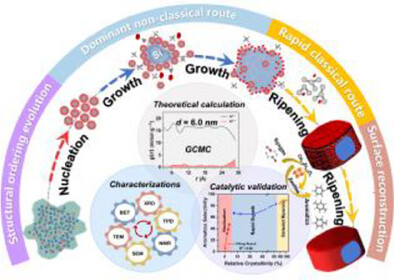Angewandte Chemie International Edition
https://doi.org/10.1002/anie.202507223

Abstract
Improving the comprehension of intricate crystallization processes at the molecular level is crucial for the customized design of efficient zeolite materials. However, the alternating dominance of classical and non-classical crystallization mechanisms, especially in multi-component solutions (monomers, oligomers, and amorphous particles), complicates mechanistic differentiation. Herein, we unveiled the structure and composition changes of ZSM-5 zeolite at various stages via selectively removing soluble species from the synthesis solution. We revealed that highly ordered, aluminum-rich subcrystals serve as essential precursors, triggering rapid non-classical aggregation growth, followed by a ripening phase dominated by single-molecule addition. Notably, aluminum species are excluded from the aggregation growth process and reincorporated via monomer addition, accounting for the compositional heterogeneity and an aluminum-enriched surface of the final product. Remarkably, for the first time, the fact and reason behind the preferential formation of aluminum-rich nuclei, as well as the changes in Al species during the rapid growth and ripening stages have well been thoroughly verified and clarified through syngas to aromatics reaction and theoretical simulations. These findings provide valuable theoretical guidance for the directional synthesis of zeolite and the control of dynamic process variables.
